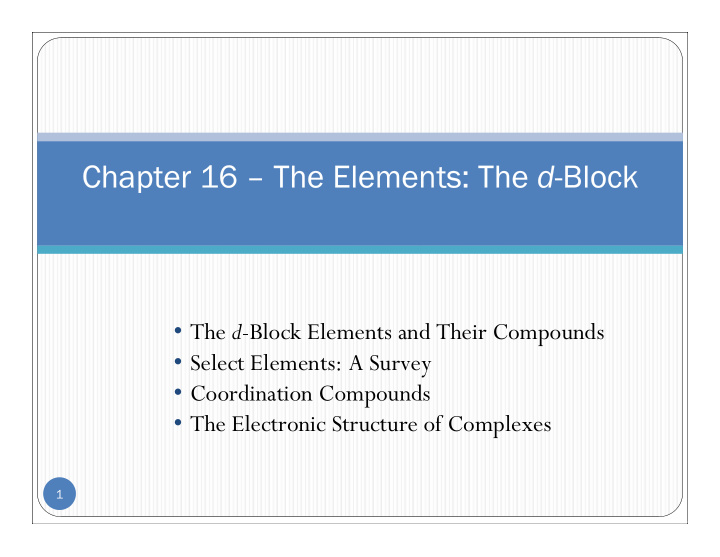



Chapter 16 – Chapter 16 – The Elements: The he Elements: The d -Block -Block • The d -Block Elements and Their Compounds • Select Elements: A Survey • Coordination Compounds • The Electronic Structure of Complexes 1
The d-Block Elements and Their Compounds The d-Block Elements and Their Compounds Location on Periodic Table Location on Periodic Table Transition metals, are located in groups 3 through 11. They are called transition metals because they transition between the highly reactive s block metals and the much less 2 reactive metals of group 12 and the p block.
The d-Block Elements and Their Compounds The d-Block Elements and Their Compounds Shape of Shape of d Orbitals Orbitals The shape of the d orbitals affect the properties of transition metals. The d orbital lobes are far apart and so only weakly repel each other. The d orbitals have low electron 3 density near the nucleus therefore are not very effective at shielding.
The The d -Block Elements and Their Compounds -Block Elements and Their Compounds Trends in Atomic Radii Trends in Atomic Radii The shape of the d orbitals affect the properties of transition metals. The d orbital lobes are far apart and thus only weakly repel each other. The d orbitals have low electron 4 density near the nucleus therefore are not very effective at shielding.
The The d -Block Elements and Their Compounds -Block Elements and Their Compounds Oxidation States Oxidation States Orange boxes are common oxidation numbers. Green boxes are other know states. Most d -block metals have more that one oxidation state other than 0. Elements close to 5 the center of the row have the widest rage of oxidation numbers.
Select Elements: A Survey Select Elements: A Survey Scandium Through Nickel Scandium Through Nickel As you go across the first period of d -metals from scandium through nickel you can see there are similarities in the melting and boiling points. In addition, their densities 6 increase as you go across the period.
Select Elements: A Survey Select Elements: A Survey Scandium Through Nickel Scandium Through Nickel Scandium (Sc) Titanium (Ti) Vanadium (V) Chromium (Cr) Facts • Reacts vigorously • Resistant to corrosion • Vanadium • Corrosion resistant with water (protective oxide skin) compounds come in a wide range of • Requires strong reducing color due to its agent for extraction many oxidation from, its ores states Uses • Few uses • Jet engines • Makes tough steels • Stainless steel for automobile and • Not essential to life • Dental applications • Chrome plating truck springs • Glazes for ceramics 7
Select Elements: A Survey Select Elements: A Survey Scandium Through Nickel Scandium Through Nickel Manganese (Mn) Iron (Fe) Cobalt (Co) Nickel (Ni) Facts • Not as corrosion • Most widely used d • 70% if the western resistant as chromium metal world’s nickel comes from but more corrosion • Most abundant ore that was brought close resistant than iron element on earth to the earth surface nearly • The second most 2 billion year ago by the abundant metal in the violent impact of a huge earths crust (after meteor aluminum) Uses • Alloying with steel • Main component in • Alloying with steal • Used to make stainless steel steal • Used to make • Essential to life permanent magnets • Nickel is alloyed with found in speakers copper to make nickel coins • Essential to life 8
Coordination Compounds Coordination Compounds Common Ligands Common Ligands 9
The Electronic Structure of Complexes The Electronic Structure of Complexes Crystal Field Theory Crystal Field Theory In crystal field theory one assumes that the ligands can be represented by negative point charges and that the metal is a positive point charge located at the center of the system. 10 One then examines how these negative point charges interact with the d orbitals
The Electronic Structure of Complexes The Electronic Structure of Complexes Spectrochemical Spectrochemical Series eries Different ligands affect the d orbitals of a given metal atom or ion to different degrees and thus produce different values of the ligand field splitting. The spectrochemical series arranges ligands according to the relative magnitudes of the ligand field splitting 11 that they produce.
The Electronic Structure of Complexes The Electronic Structure of Complexes Electron Configurations Electron Configurations 12
The Electronic Structure of Complexes The Electronic Structure of Complexes Ligand Field Theory Ligand Field Theory Only one orbital is considered for the ligands. 9 orbitals come from the d -metal, 6 orbitals come from the ligands making a total of 15 molecular orbitals. The electrons from the ligands fill up all of the bonding orbitals, leaving the electrons from the metal 13 to fill the nonbonding and antibonding orbitals.
The Electronic Structure of Complexes The Electronic Structure of Complexes Ligand Field Theory Ligand Field Theory Weak Field Ligand If the t 2g orbital is closer in energy to the π bonding orbital, the two orbitals will interact and the electron in the filled π orbitals will enter the lower energy molecular orbital therefore the electrons in the d -metal will have to occupy the higher energy molecular orbital which will decreases the octahedral field splitting. This is what 14 happens for weak field ligands.
The Electronic Structure of Complexes The Electronic Structure of Complexes Ligand Field Theory Ligand Field Theory Strong Field Ligand If however the t 2g orbitals are closer in energy to the π antibonding orbital when the two orbitals interact, there are no electrons from the ligand to go into the lower energy molecular orbital. Therefore the electrons in the metal can enter the lower energy orbital and the octahedral field splitting will increase. This is what happens for strong 15 field ligands.
Recommend
More recommend